Addressing Wildfire Risk in Forest Management Planning with Multiple Criteria Decision Making Methods
Abstract
:1. Introduction
2. Material and Methods
2.1. The Study Area
2.2. Model Building
- is the number of stands;
- Mi is the number of prescriptions for stand i;
- T is the number of planning periods;
- xij is the number of ha of stand i assigned to prescription j;
- is the total area (hectares) of stand i;
- FA is the total forested area (hectares) in the ZIF_VS;
- pinewijt is the pine sawlog volume (m3) per hectare in period t that results from assigning one hectare of stand i to prescription j;
- PineWt is the pine sawlog volume (m3) produced in period t;
- PineSawlogs is the total volume of pine sawlogs (m3) produced during the planning horizon;
- eucalyptwijt is the eucalypt pulpwood volume (m3) per hectare in period t that results from assigning one hectare of stand i to prescription j;
- EucalyptWt is the eucalypt pulpwood volume (m3) produced in period t;
- EucalyptPulpwood is the total volume of eucalypt pulpwood m3) produced during the planning horizon;
- chestnutwijt is the chestnut sawlog volume (m3) per hectare in period t that results from assigning one hectare of stand i to prescription j;
- ChestnutWt is the chestnut sawlog volume (m3) produced in period t;
- ChestnutSawlogs is the chestnut sawlog volume (m3) produced during the planning horizon;
- carbijt is average yearly carbon stock (tonnes) per hectare in period t that results from assigning one hectare of stand i to prescription j;
- Carbt is average yearly carbon stock (tonnes) for the forest as a whole in period t;
- CARB is average yearly carbon stock (tonnes) for the forest as a whole over the planning horizon;
- npvij is net present value (€) per hectare produced by prescription j in stand i;
- NPVj is net present value (€) of the plan for the forest as a whole;
- csij is the discounted cost of fuel treatments (€) per hectare for prescription j in stand i;
- C is the total discounted cost of fuel treatments (€);
- veiij is the standing volume of ending inventory (m3) per hectare in stand i under prescription j;
- VEI is the standing volume of ending inventory (m3) for the forest as a whole;
- F is the number of forest management programs;
- FMPif is the set of prescriptions for stand i that were classified as belonging to forest management program f;
- is the area assigned to forest management program f (hectares);
- rijt is the expected percentage of surviving trees in stand i in period t under prescription j;
- Rit is the specific wildfire resistance of stand i in period t, with Rit [0,1];
- WFt is the average specific wildfire resistance of the forested landscape in period t, with WFt [0,1];
- WF is the average specific wildfire resistance of the forested landscape over the planning horizon, with WF [0,1];
- Rst is the adjusted wildfire resistance of stand s neighbor of stand i in period t, with Rst [0,1];
- is the set of neighbors of stand i;
- Rait is the adjusted wildfire resistance of stand i in period t, with Rait [0,1]; Rait incorporates the wildfire resistance levels of adjacent stands and the risk of fire spread;
- is a weight that reflects the impact of neighboring stands on the wildfire resistance of stand i; [0,1]; wi depends on parameters that reflect the size and shape of the stand i; we assume wi > 0;
- is a parameter that reflects the likelihood that a fire that occurs in stand s will spread to stand i; and . [52].
- WFat is the forested landscape adjusted specific resistance in period t, with WFat [0,1];
- WFa is the average adjusted specific resistance of the forested landscape over the planning horizon, with WFa [0,1].
3. Results
4. Discussion
5. Conclusions
Acknowledgments
Author Contributions
Conflicts of Interest
References
- Tóth, S.F.; McDill, M.E.; Rebain, S. Finding the Efficient Frontier of a Bi-Criteria, Spatially Explicit, Harvest Scheduling Problem. For. Sci. 2006, 52, 93–107. [Google Scholar]
- Diaz-Balteiro, L.; Romero, C. Making forestry decisions with multiple criteria. A review and an assessment. For. Ecol. Manag. 2008, 255, 3222–3241. [Google Scholar] [CrossRef]
- Belton, V.; Stewart, T.J. Multiple Criteria Decision Analysis—An Integrated Approach; Kluwer Academic Publishers: Dordrecht, The Netherlands, 2002. [Google Scholar]
- Tóth, S.F.; McDill, M.E. Finding Efficient Harvest Schedules under Three Conflicting Objectives. For. Sci. 2009, 55, 117–131. [Google Scholar]
- Borges, J.G.; Garcia-Gonzalo, J.; Bushenkov, V.; McDill, M.E.; Marques, S.; Oliveira, M.M. Addressing multicriteria forest management with Pareto frontier methods: An application in Portugal. For. Sci. 2014, 60, 63–72. [Google Scholar] [CrossRef]
- Garcia-Gonzalo, J.; Bushenkov, V.; McDill, M.E.; Borges, J. A Decision Support System for Assessing Trade-Offs between Ecosystem Management Goals: An Application in Portugal. Forests 2015, 6, 65–73. [Google Scholar] [CrossRef]
- Armstrong, G.W. Sustainability of timber supply considering the risk of wildfire. For. Sci. 2005, 50, 626–639. [Google Scholar]
- Calkin, D.E.; Hummel, S.S.; Agee, J.K. Modeling trade-offs between fire threat reduction and late-seral forest structure. Can. J. For. Res. 2005, 35, 2562–2574. [Google Scholar] [CrossRef]
- Konoshima, M.; Albers, H.J.; Montgomery, C.A.; Arthur, J.L. Optimal spatial patterns of fuel management and timber harvest with fire risk. Can. J. For. Res. 2010, 40, 95–108. [Google Scholar] [CrossRef]
- Konoshima, M.; Montgomery, C.A.; Albers, H.J.; Arthur, J.L. Spatial-endogenous fire risk and efficient fuel management and timber harvest. Land. Econ. 2008, 84, 449–468. [Google Scholar] [CrossRef]
- Lampin-Maillet, C.; Long-Fournel, M.; Ganteaume, A.; Jappiot, M.; Ferrier, J.P. Land cover analysis in wildland-urban interfaces according to wildfire risk: A case study in the South of France. For. Ecol. Manag. 2011, 261, 2200–2213. [Google Scholar] [CrossRef]
- Catry, F.X.; Rego, F.C.; Bacao, F.L.; Moreira, F. Modeling and mapping wildfire ignition risk in Portugal. Int. J. Wildland Fire 2009, 18, 1–11. [Google Scholar] [CrossRef]
- Catry, F.X.; Rego, F.; Moreira, F.; Fernandes, P.M.; Pausas, J.G. Post-fire tree mortality in mixed forests of central Portugal. For. Ecol. Manag. 2010, 260, 1184–1192. [Google Scholar] [CrossRef]
- Marques, S.; Borges, J.G.; Garcia-Gonzalo, J.; Moreira, F.; Carreiras, J.M.B.; Oliveira, M.M.; Cantarinha, A.; Botequim, B.; Pereira, J.M.C. Characterization of wildfires in Portugal. Eur. J. For. Res. 2011, 130, 775–784. [Google Scholar] [CrossRef]
- Paton, D.; Tedim, F. Enhancing forest fires preparedness in Portugal: Integrating community engagement and risk management. Planet@Risk 2013, 1, 44–52. [Google Scholar]
- Bar Massada, A.; Radeloff, V.C.; Steward, S.I.; Hawbaker, T.J. Wildfire risk in the wildland–urban interface: A simulation study in northwestern Wisconsin. For. Ecol. Manag. 2009, 258, 1990–1999. [Google Scholar] [CrossRef]
- Hardy, C. Wildland fire hazard and risk, problems, definitions and context. For. Ecol. Manag. 2005, 211, 73–82. [Google Scholar] [CrossRef]
- Bachmann, A.; Allgower, B. The need for a consistent wildfire risk terminology. In Crossing the Millennium: Integrating Spatial Technologies and Ecological Principles for a New Age in Fire Management; Neuenschwander, L., Ryan, K., Golberg, G., Eds.; The University of Idaho and the International Association of Wildland Fire: Moscow, Russia, 2000; pp. 67–77. [Google Scholar]
- González, J.R.; Palia, M.; Pukkala, T. A fire probability model for forest stands in Catalonia (north-east Spain). Ann. For. Sci. 2006, 63, 1–8. [Google Scholar] [CrossRef]
- Jactel, H.; Nicoll, B.C.; Branco, M.; González-Olabarria, J.R.; Grodzki, W.; Långström, B.; Moreira, F.; Netherer, S. The influences of forest stand management on biotic and abiotic risks of damage. Ann For. Sci. 2009, 66, 701. [Google Scholar] [CrossRef]
- Jappiot, M.; Gonzalez-Olabarria, J.R.; Lampin-Maillet, C.; Borgniet, L. Assessing Wildfire Risk in Time and Space. In Living with Wildfires: What Science Can Tell Us; A contribution to the Science-Policy Dialogue; European Forest Institute: Barcelona, Spain, 2009; pp. 41–47. [Google Scholar]
- Garcia-Gonzalo, J.; Zubizarreta-Gerendiain, A.; Ricardo, A.; Marques, S.; Botequim, B.; Borges, J.G.; Oliveira, M.M.; Tomé, M.; Pereira, J.M.C. Modelling wildfire risk in pure and mixed forest stands in Portugal. Allg. Forst. 2012, 183, 238–248. [Google Scholar]
- Marques, S.; Garcia-Gonzalo, J.; Botequim, B.; Ricardo, A.; Borges, J.G.; Tomé, M.; Oliveira, M.M. Assessing wildfire occurrence probability in Pinus pinaster Ait. stands in Portugal. For. Syst. 2012, 21, 111–120. [Google Scholar] [CrossRef]
- Botequim, B.; Garcia-Gonzalo, J.; Marques, S.; Ricardo, A.; Borges, J.G.; Tomé, M.; Oliveira, M.M. Developing wildfire risk probability models for Eucalyptus globulus stands in Portugal. iForest 2013, 6, 217–227. [Google Scholar] [CrossRef]
- González, J.R.; Pukkala, T. Characterization of forest fires in Catalonia (north-east Spain). Eur. J. For. Res. 2007, 126, 421. [Google Scholar] [CrossRef]
- Ager, A.A.; Vaillant, N.M.; Finney, M.A. A comparison of landscape fuel treatment strategies to mitigate wildland fire risk in the urban interface and preserve old forest structure. For. Ecol. Manag. 2010, 259, 1556–1570. [Google Scholar] [CrossRef]
- Finney, M.A.; Seli, R.C.; McHugh, C.W.; Ager, A.A.; Bahro, B.; Agee, J.K. Simulation of Long-Term Landscape-Level Fuel Treatment Effects on Large Wildfires. Int. J. Wildland Fire 2007, 16, 712–727. [Google Scholar] [CrossRef]
- González-Olabarria, J.R.; Pukkala, T. Integrating fire risk considerations in landscape-level forest planning. For. Ecol. Manag. 2007, 261, 278–287. [Google Scholar] [CrossRef]
- González-Olabarria, J.R.; Rodríguez, F.; Fernández-Landa, A.; Mola-Yudego, B. Mapping fire risk in the Model Forest of Urbión (Spain) based on airborne LiDAR measurements. For. Ecol. Manag. 2012, 282, 149–156. [Google Scholar]
- Kaloudis, S.; Tocatlidou, A.; Lorentzos, N.A.; Sideridis, A.B.; Karteris, M. Assessing wildfire destruction danger: A decision support system incorporating uncertainty. Ecol. Model. 2005, 181, 25–38. [Google Scholar] [CrossRef]
- Verde, J.C.; Zêzere, J.L. Assessment and validation of wildfire susceptibility and hazard in Portugal. Nat. Hazards Earth Syst. Sci. 2010, 10, 485–497. [Google Scholar] [CrossRef]
- Yassemi, S.; Dragícevic, S.; Schimidt, M. Design and implement of an integrated GIS-based cellular automata model to characterize forest fire behavior. Ecol. Model. 2008, 210, 71–84. [Google Scholar] [CrossRef]
- Alonzo-Betanzos, A.; Fontanela-Romeo, O.; Guijarro-Berdiñas, B.; Hernández-Pereira, E.; Andrade, M.; Jiménez, E.; Soto, J.; Carballas, T. An intelligent system for forest fire risk prediction and firefighting management in Galicia. Expert Syst. Appl. 2003, 25, 545–554. [Google Scholar] [CrossRef]
- Braun, W.; Jones, B.; Lee, J.; Woolford, D.; Wotton, B. Forest fire risk assessment: An illustrative example from Ontario, Canada. J. Prob. Stat. 2010, 26. [Google Scholar] [CrossRef]
- Barros, A.M.G.; Pereira, J.M.C. Wildfire selectivity for land cover type: Does size matter? PLoS ONE 2014, 9, 1–10. [Google Scholar] [CrossRef] [PubMed]
- Schimidt, D.; Taylor, A.; Skinner, C. The influence of fuels treatment and landscape arrangement on simulated fire behavior, Southern Cascade rande, California. For. Ecol. Manag. 2008, 255, 3170–3184. [Google Scholar] [CrossRef]
- Grishin, A.M.; Filkov, A.I. A deterministic-probabilistic system for predicting forest fire hazard. Fire Saf. J. 2011, 46, 56–62. [Google Scholar] [CrossRef]
- Keane, R.E.; Drury, S.A.; Karau, E.C.; Hessburg, P.F.; Reynolds, K.M. A method for mapping fire hazard and risk across multiple scales and its application in fire management. Ecol. Model. 2010, 221, 2–18. [Google Scholar] [CrossRef]
- Paz, S.; Carmel, Y.; Jahshan, F.; Shoshany, M. Post fire analysis of pre-fire mapping of fire risk: A recent case study from Mt. Carmel (Israel). For. Ecol. Manag. 2011, 262, 1184–1188. [Google Scholar] [CrossRef]
- Chuvieco, E.; Congalton, R. Apllication of remote sensing and geographic information systems to forest fire hazard mapping. Remote Sens. Environ. 1989, 29, 147–159. [Google Scholar] [CrossRef]
- Chuvieco, E.; Aguado, I.; Yebra, M.; Nieto, H.; Salas, J.; Martín, M.P.; Vilar, L.; Martínez, J.; Martín, S.; Ibarra, P.; et al. Development of a framework for fire risk assessment using remote sensing and geographic information system technologies. Ecol. Model. 2010, 221, 46–58. [Google Scholar] [CrossRef]
- Chuvieco, E.; Aguado, I.; Jurdao, S.; Pettinari, M.L.; Yebra, M.; Salas, J.; Hantson, S.; de la Riva, J.; Ibarra, P.; Rodrigues, M.; et al. Integrating geospatial information into fire risk assessment. Int. J. Wild. Fire 2012, 23, 606–619. [Google Scholar] [CrossRef]
- Ager, A.; Valillant, N.; Finney, M. Integrating fire behavior models and geospatial analysis for wildland fire risk assessment and fuel management planning. J. Combust. 2011. [Google Scholar] [CrossRef]
- Aretano, R.; Semeraro, T.; Petrosillo, I.; De Marco, A.; Pasimeni, M.R.; Zurlini, G. Mapping ecological vulnerability to fire for effective conservation management of natural protected areas. Ecol. Model. 2015, 295, 163–175. [Google Scholar] [CrossRef]
- Bonazountas, M.; Kallidromitou, D.; Kassomenos, P.; Passas, N. A decision support system for managing forest fire casualities. J. Environ. Manag. 2007, 84, 412–418. [Google Scholar] [CrossRef] [PubMed]
- Bonazountas, M.; Kallidromitou, D.; Kassomenos, P.; Passas, N. Forest fire risk analysis. Hum. Ecol. Risk Assess. 2005, 11, 617–626. [Google Scholar] [CrossRef]
- Sauvagnargues-Lesage, S.; L’Hëritier, B.; Boussardon, T. Implementation of a GIS application for French fire-fighters in the Mediterranean area. Comput. Environ. Urban Syst. 2001, 25, 307–318. [Google Scholar] [CrossRef]
- San-Miguel-Ayanz, J.; Barbosa, P.; Schmuck, G.; Libertà, G.; Meyer-Roux, J. The European Forest Fire Information System. In Proceedings of the 6th AGILE, Lyon, France, 24–26 April 2003; pp. 27–30.
- Jaiswal, R.; Mukherjee, S.; Raju, K.; Saxena, R. Forest fire risk zone mapping from satellite imagery and GIS. Int. J. Appl. Earth Obs. 2002, 4, 1–10. [Google Scholar] [CrossRef]
- Carmel, Y.; Paz, S.; Jahashan, F.; Maxim, S. Assessing fire risk using Monte Carlo simulations of fire spread. For. Ecol. Manag. 2009, 257, 370–377. [Google Scholar] [CrossRef]
- Ferreira, L.; Constantino, M.F.; Boges, J.G.; Garcia-Gonzalo, J. Addressing wildfire risk in landscape-level scheduling model: An application in Portugal. For. Sci. 2015, 61, 266–277. [Google Scholar] [CrossRef]
- Botequim, B.; Zubizarreta-Gerendiain, A.; Garcia-Gonzalo, J.; Silva, A.; Marques, S.; Fernandes, P.; Pereira, J.; Tomé, M. A model of shrub biomass accumulation as a tool to support management of Portuguese forests. iForest 2015, 8, 114–125. [Google Scholar] [CrossRef]
- Marques, S.; Garcia-Gonzalo, J.; Borges, J.G.; Botequim, B.; Oliveira, M.M.; Tomé, J.; Tomé, M. Developing post-fire Eucalyptus globulus stand damage and tree mortality models for enhanced forest planning in Portugal. Silva Fenn. 2011, 45, 69–83. [Google Scholar] [CrossRef]
- Garcia-Gonzalo, J.; Marques, S.; Borges, J.G.; Botequim, B.; Oliveira, M.M.; Tomé, J.; Tomé, M. A three-step approach to post-fire mortality modeling in Maritime pine (Pinus pinaster Ait.) stands for enhanced forest planning in Portugal. Forestry 2011, 84, 197–206. [Google Scholar] [CrossRef]
- Kangas, J.; Kangas, A. Multiple criteria decision support in forest management—The approach, methods applied, and experiences gained. For. Ecol. Manag. 2005, 207, 133–143. [Google Scholar] [CrossRef]
- Nordström, E.-M.; Eriksson, L.O.; Öhman, K. Integrating multiple criteria decision analysis in participatory forest planning: Experience from a case study in northern Sweden. For. Pol. Econ. 2010, 12, 562–574. [Google Scholar] [CrossRef]
- Korosuo, A.; Wikström, P.; Öhman, K.; Eriksson, L.O. An integrated mcda software application for forest planning: A case study in southwestern Sweden. Math. Comput. For. Nat. Resour. Sci. 2011, 3, 75–86. [Google Scholar]
- Kangas, A.; Kangas, J.; Pykäläinen, J. Outranking methods as tools in strategic natural resources planning. Silva Fenn. 2001, 35, 215–227. [Google Scholar] [CrossRef]
- Lotov, A.V.; Bushenkov, V.A.; Kamenev, G.K. Interactive Decision Maps: Approximation and Visualization of Pareto Frontier; Kluwer Academic Publishers: Norwell, MA, USA, 2004; p. 319. [Google Scholar]
- Borges, J.G.; Marques, S.; Garcia-Gonzalo, J.; Rahman, A.U.; Bushenkov, V.; Sottomayor, M.; Carvalho, P.O.; Nordström, E.M. Negotiating ecosystem services supply targets as well as forest owners behaviors and programs with multiple criteria methods. For. Sci. 2017, 63, 49–61. [Google Scholar]
- Borges, J.G.; Falcão, A.; Miragaia, C.; Marques, P.; Marques, M. A decision support system for forest resources management in Portugal. In Managing Forest Ecosystems; Arthaud, G.J., Barrett, T.M., Eds.; Springer: Dordrecht, The Netherlands, 2003; Volume 7, pp. 155–164. [Google Scholar]
- Ribeiro, R.P.; Borges, J.G.; Oliveira, V. A framework for data quality for Mediterranean sustainable ecosystem management. Ann. For. Sci. 2004, 61, 557–568. [Google Scholar] [CrossRef]
- Falcão, A.; Borges, J.G. Designing decision support tools for Mediterranean forest ecosystems management: A case study in Portugal. Ann. For. Sci. 2005, 62, 751–760. [Google Scholar] [CrossRef]
- Garcia-Gonzalo, J.; Palma, J.; Freire, J.; Tomé, M.; Mateus, R.; Rodriguez, L.C.E.; Bushenkov, V.; Borges, J.G. A decision support system for a multi stakeholder’s decision process in a Portuguese National Forest. For. Syst. 2013, 22, 359–373. [Google Scholar] [CrossRef]
- Davis, L.S.; Johnson, K.N. Forest Management, 3rd ed.; McGraw Hill Publishing Company: New York, NY, USA, 2001. [Google Scholar]
- Nunes, L.; Tomé, J.; Tomé, M. Prediction of annual tree growth and survival for thinned and unthinned even-aged maritime pine stands in Portugal from data with different time measurement intervals. For. Ecol. Manag. 2011, 262, 1491–1499. [Google Scholar] [CrossRef]
- Nunes, L.; Patrício, M.; Tomé, J.; Tomé, M. Modeling dominant height growth of maritime pine in Portugal using GADA methodology with parameters depending on soil and climate variables. Ann. For. Sci. 2011, 68, 311–323. [Google Scholar] [CrossRef]
- Alegria, C.M.M. PBIRROL Modelo de Crescimento e Produção para os Povoamentos de Pinheiro bravo de Estrutura Irregular do Concelho de Oleiros; Instituto Politécnico de Castelo Branco: Castelo Branco, Portugal, 2007; pp. 13–18. (In portuguese) [Google Scholar]
- Tomé, M.; Oliveira, T.; Soares, P. O modelo Globulus 3.0. Publicações GIMREF—RC2/2006; Instituto Superior de Agronomia: Lisboa, Portugal, 2006; p. 23. Available online: http://www.repository.utl.pt/handle/10400.5/1760 (accessed on 15 February 2017). (In portuguese)
- Barreiro, S.; Tomé, M.; Tomé, J. Modeling Growth of Unknown Age Even-aged Eucalyptus Stands. In Modeling Forest Production. Scientific Tools—Data Needs and Sources. Validation and Application, Proceedings of the International IUFRO Congress, Vienna, Austria, 19–22 April 2004; Hasenauer, H., Mäkelä, A., Eds.; U.S. National Library of Medicine: Bethesda, MD, USA, 2004; pp. 34–43. [Google Scholar]
- Barreiro, S.; Rua, J.; Tomé, M. StandsSIM-MD: A Management Driven forest SIMulator. For. Syst. 2016, 25, 7. [Google Scholar] [CrossRef]
- Monteiro, M.L.; Patrício, M.S. O castanheiro: Modelos de gestão. Revist. Florest. 1996, 9, 51–56. (In Portuguese) [Google Scholar]
- González, J.R.; Palahí, M.; Pukkala, T. Integrating fire risk considerations in forest management planning in Spain—A landscape level perspective. Landsc. Ecol. 2005, 20, 957–970. [Google Scholar] [CrossRef]
- Garcia-Gonzalo, J.; Pukkala, T.; Borges, J.G. Integrating fire risk in stand management scheduling. An application to Maritime pine stands in Portugal. Ann. Oper. Res. 2014, 219, 379–395. [Google Scholar] [CrossRef]
- Ferreira, L.; Constantino, M.; Borges, J.G. A stochastic approach to optimize Maritime pine (Pinus pinaster Ait.) stand management scheduling under fire risk: An application in Portugal. Ann. Oper. Res. 2014, 219, 359–377. [Google Scholar] [CrossRef]
- Rodríguez y Silvaa, F.; Molinaa, J.R.; González-Cabánb, A.; Machuca, M.A.H. Economic vulnerability of timber resources to forest fires. J. Environ. Manag. 2012, 100, 16–21. [Google Scholar] [CrossRef] [PubMed]
- Kaloudis, S.; Costopoulou, C.I.; Lorentzos, N.A.; Sideridis, A.B.; Karteris, M. Design of forest management planning DSS for wildfire risk reduction. Ecol. Inform. 2008, 3, 122–133. [Google Scholar] [CrossRef]
- McArthur, A.G. Fire Behaviour in Eucalypt Forests; Forestry and Timber Bureau: Canberra, Australia, 1967.
- Van Wagner, C.E. Effect of slope on fires spreading downhill. Can. J. For. Res. 1988, 18, 818–820. [Google Scholar] [CrossRef]
- Cumming, S.G. Forest type and wildfire in the Alberta boreal mixedwood: What do fires burn? Ecol. Appl. 2001, 11, 97–110. [Google Scholar] [CrossRef]
- Castro, F.X.; Tudela, A.; Sebastià, M.T. Modeling moisture content in shrubs to predict fire risk in Catalonia (Spain). Agric. For. Meteol. 2003, 116, 49–59. [Google Scholar] [CrossRef]
- Fernandes, P.; Luz, A.; Loureiro, C. Changes in wildfire severity from maritime pine woodland to contiguous forest types in the mountain of northwestern Portugal. For. Ecol. Manag. 2010, 260, 883–892. [Google Scholar] [CrossRef]
- Schmidt, K.M.; Menakis, J.P.; Hardy, C.C.; Hann, W.J.; Bunnell, D.L. Development of Coarse-Scale Spatial Data for Wildland Fire and Fuel Management; Gen. Tech. Rep. RMRS-GTR-87; Department of Agriculture, Forest Service, Rocky Mountain Research Station: Fort Collins, CO, USA, 2002.
- Kalabokis, K.D.; Omi, P.N. Reduction of fire hazard through thinning/residue disposal in the urban interface. Int. J. Wildland Fire 1998, 8, 29–35. [Google Scholar] [CrossRef]
- Agee, J.K.; Skinner, C.N. Basic principles of forest fuels management. For. Ecol. Manag. 2005, 211, 83–96. [Google Scholar] [CrossRef]
- Crecente-Campo, F.; Marshall, P.; Rodríguez-Soalleiro, R. Modeling non-catastrophic individual-tree mortality for Pinus radiata plantations in northwestern Spain. For. Ecol. Manag. 2009, 257, 1542–1550. [Google Scholar] [CrossRef]
- Van Wangner, C.E. Conditions for the start and spread of crown fire. Can. J. For. Res. 1977, 7, 23–34. [Google Scholar] [CrossRef]
- Finney, M.A. The challenge of quantitative risk analysis for wildland fire. For. Ecol. Manag. 2005, 211, 97–108. [Google Scholar] [CrossRef]
- Anderson, H. Aids to Determining Fuel Models for Estimating Fire Behavior; General Technical Report INT-122; USDA Forest Service, Intermountain Forest and Range Experiment Station: Ogden, UT, USA, 1982; p. 22. [Google Scholar]
- Raison, R.J.; Woods, P.V.; Khanna, P.K. Dynamics of fine fuels in recurrently burnt eucalypt forests. Aust. For. 1983, 46, 294–302. [Google Scholar] [CrossRef]
- Keane, R.E.; Burgan, R.v.W.J. Mapping wildland fuels for fire management across multiple scales: Integrating remote sensing, GIS, and biophysical modeling. Int. J. Wildland Fire 2001, 10, 301–319. [Google Scholar] [CrossRef]
- He, H.S.; Shang, B.Z.; Crow, T.R.; Gustafson, E.J.; Shifley, S.R. Simulating forest fuel and fire risk dynamics across landscapes—LANDIS fuel module design. Ecol. Model. 2004, 180, 135–151. [Google Scholar] [CrossRef]
- Rico, M.; González, A. Social participation into regional forest planning attending to multifunctional objectives. For. Policy Econ. 2015, 59, 27–34. [Google Scholar] [CrossRef]
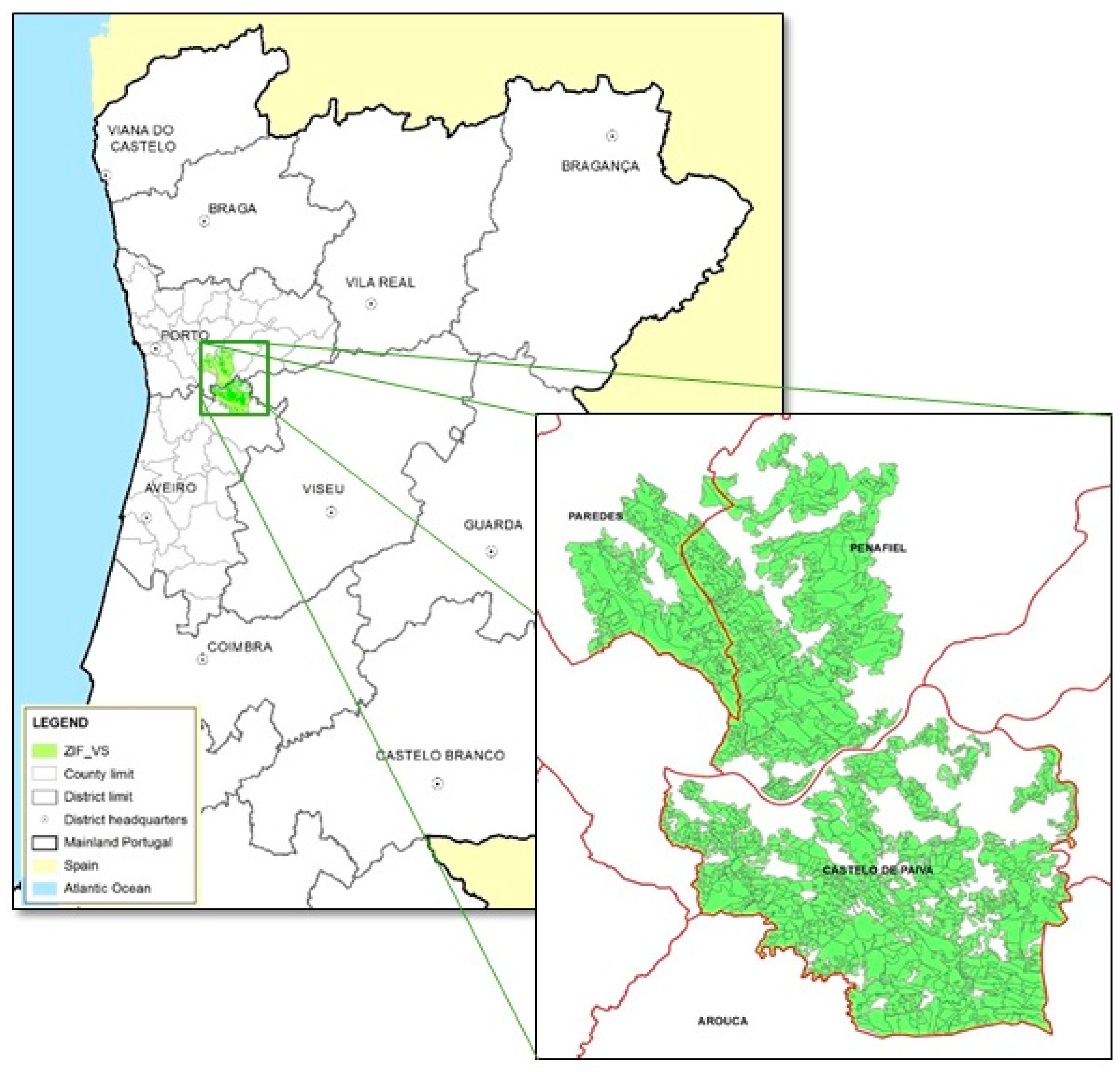
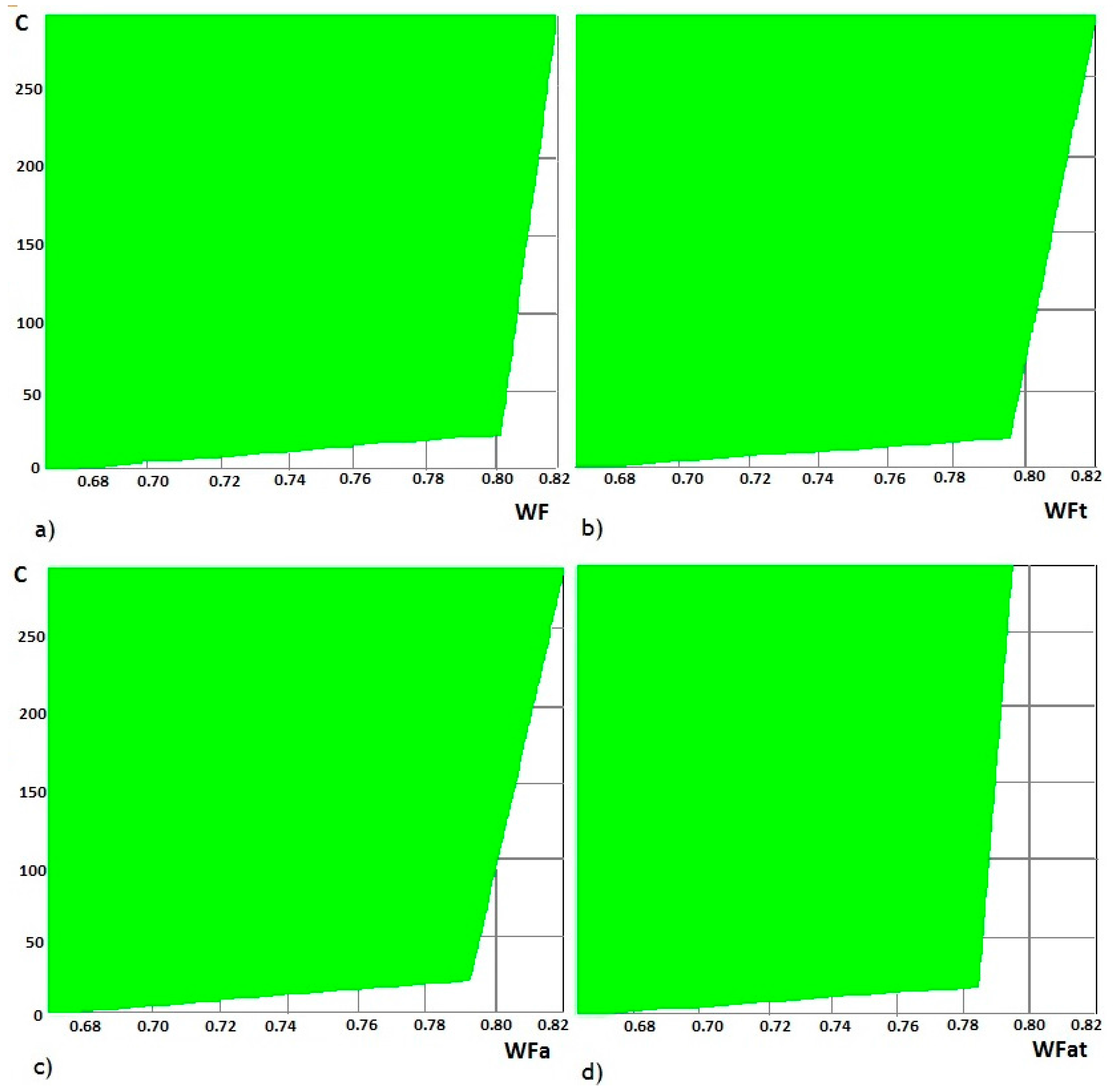
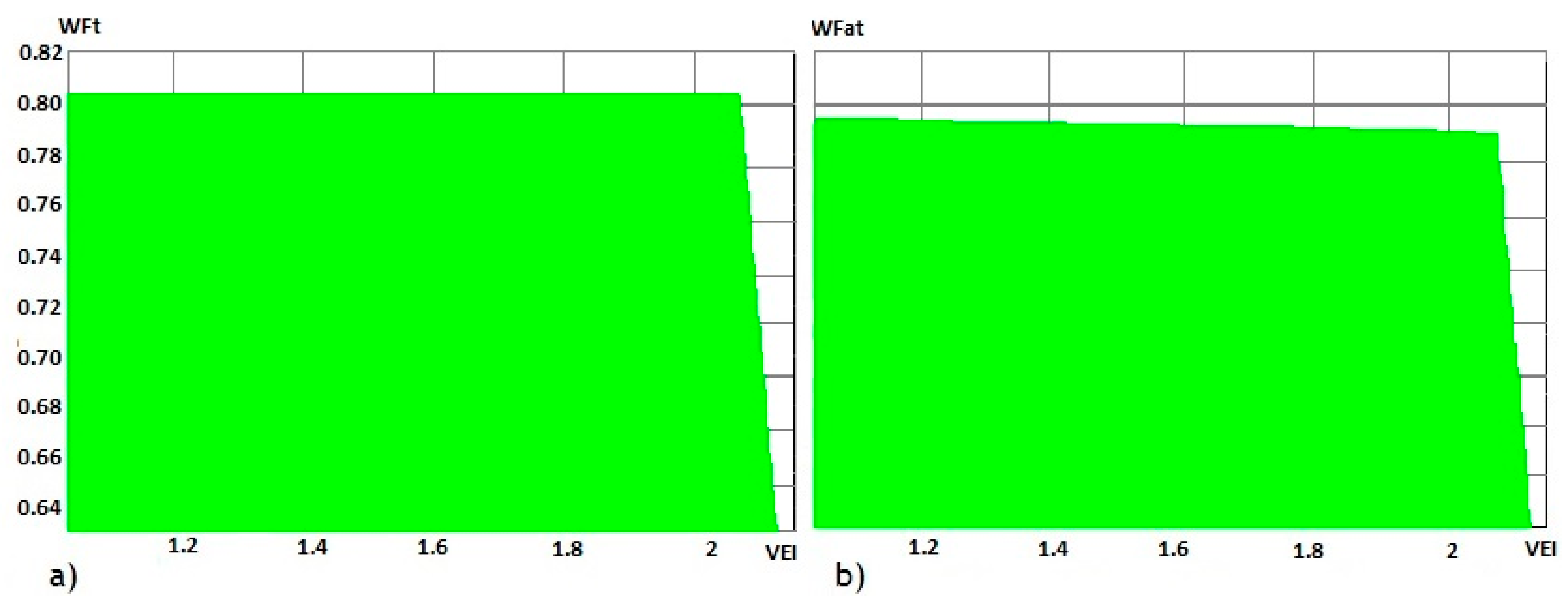

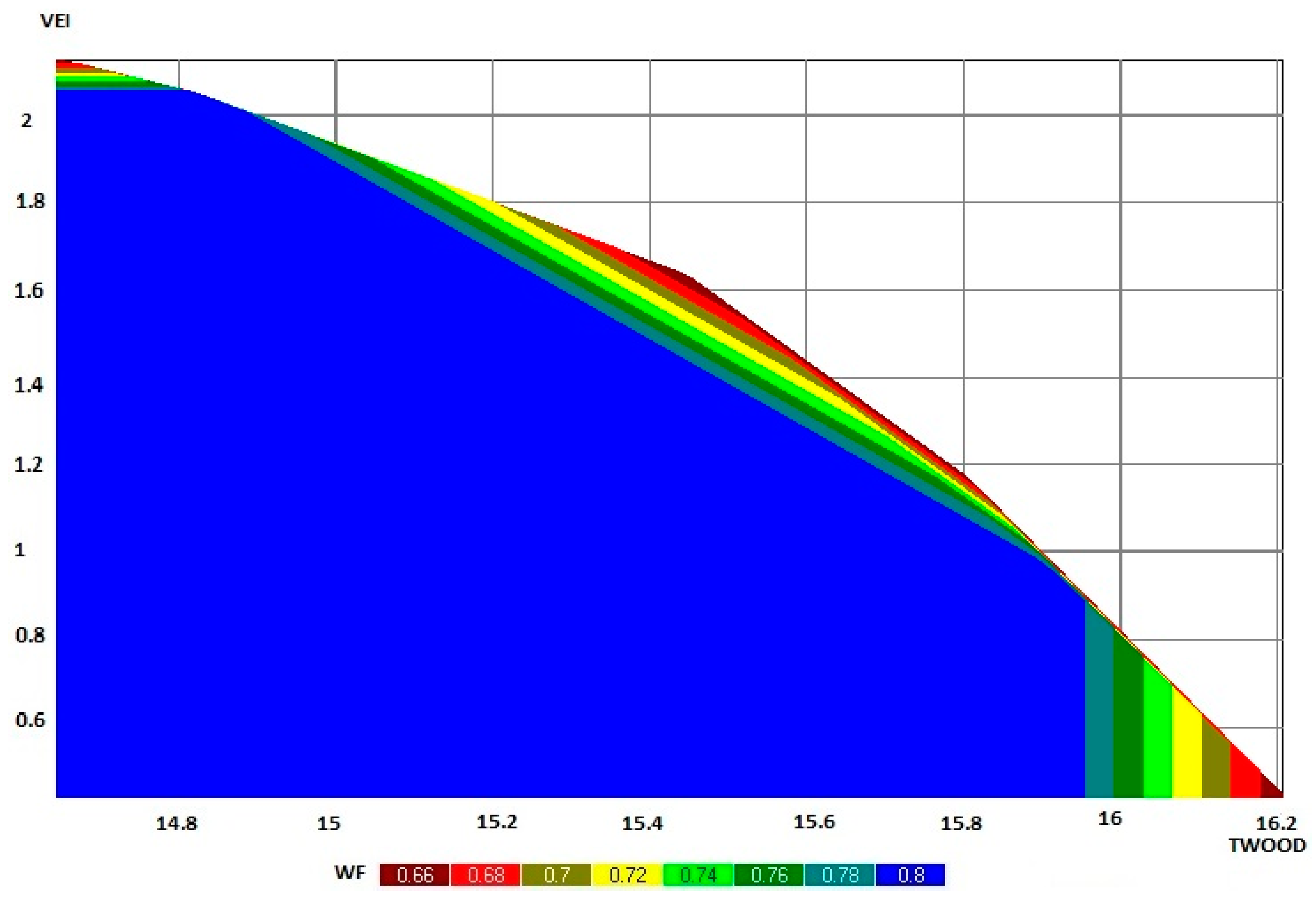
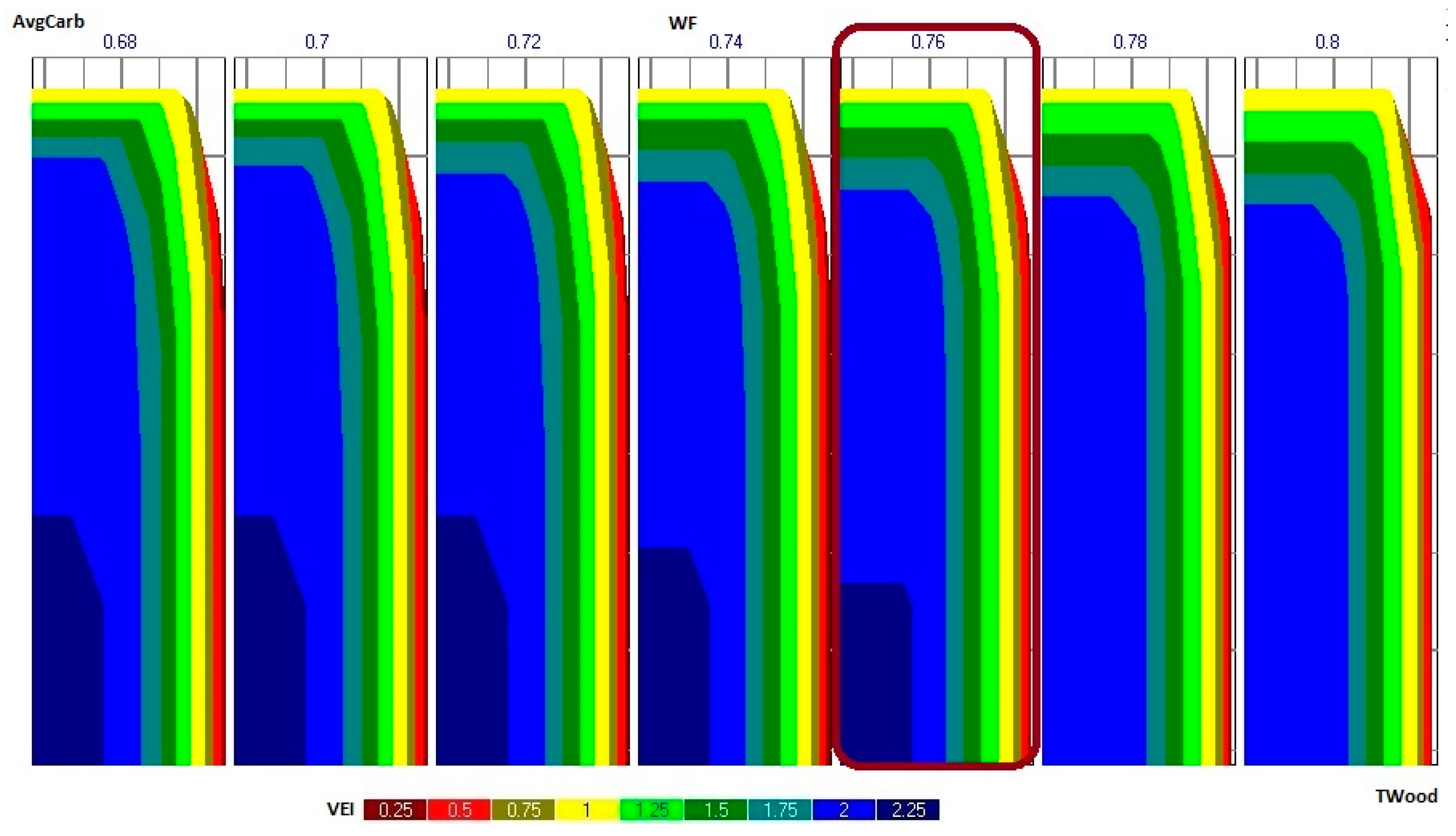
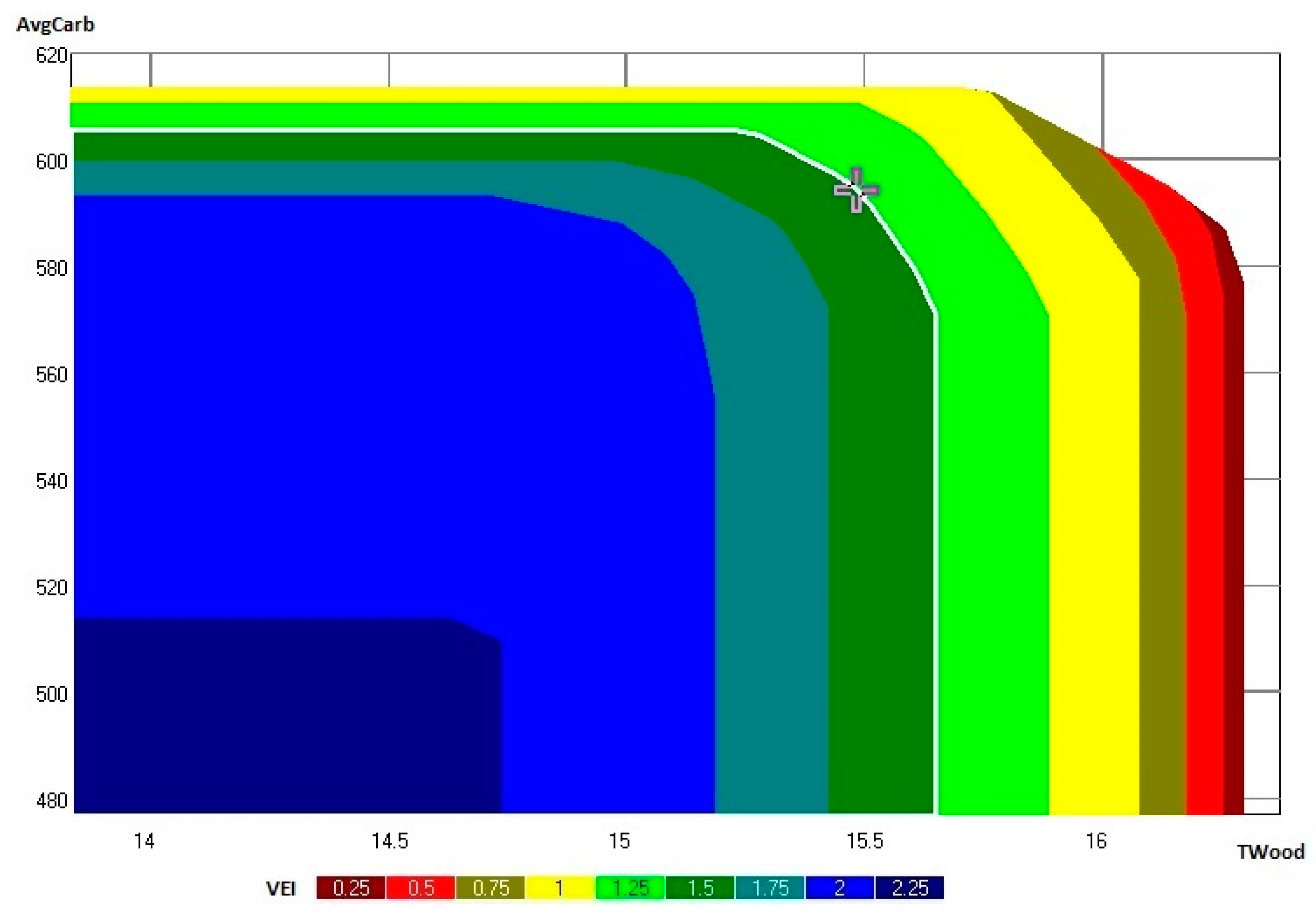
| Ecosystem Service List | Value | Units |
|---|---|---|
| HV_Euc | 14.72 | 106 m3 |
| HV_Mp | 0.23 | 106 m3 |
| HV_Chest | 0.14 | 106 m3 |
| Thwood | 0.39 | 106 m3 |
| TWood | 15.48 | 106 m3 |
| AvgCarb | 593.47 | 103 Mg·year−1 |
| VolEI | 1.5 | 106 m3 |
| Euc area | 12729.9 | Ha |
| MP area | 1174.5 | Ha |
| Chestnut area | 256.9 | Ha |
| AreaConvMPChest | 355.39 | Ha |
| WF | 0.760 | - |
| WFT | 0.747 | - |
| Wfa | 0.742 | - |
| WFaT | 0.731 | - |
| FTCosts | 145.41 | €104 |
© 2017 by the authors. Licensee MDPI, Basel, Switzerland. This article is an open access article distributed under the terms and conditions of the Creative Commons Attribution (CC BY) license ( http://creativecommons.org/licenses/by/4.0/).
Share and Cite
Marques, S.; Marto, M.; Bushenkov, V.; McDill, M.; Borges, J. Addressing Wildfire Risk in Forest Management Planning with Multiple Criteria Decision Making Methods. Sustainability 2017, 9, 298. https://doi.org/10.3390/su9020298
Marques S, Marto M, Bushenkov V, McDill M, Borges J. Addressing Wildfire Risk in Forest Management Planning with Multiple Criteria Decision Making Methods. Sustainability. 2017; 9(2):298. https://doi.org/10.3390/su9020298
Chicago/Turabian StyleMarques, Susete, Marco Marto, Vladimir Bushenkov, Marc McDill, and JoséG. Borges. 2017. "Addressing Wildfire Risk in Forest Management Planning with Multiple Criteria Decision Making Methods" Sustainability 9, no. 2: 298. https://doi.org/10.3390/su9020298






